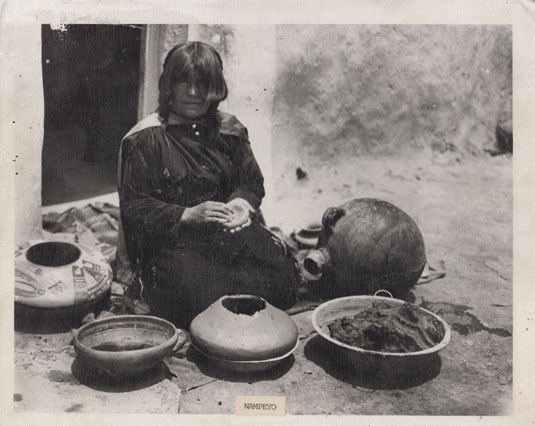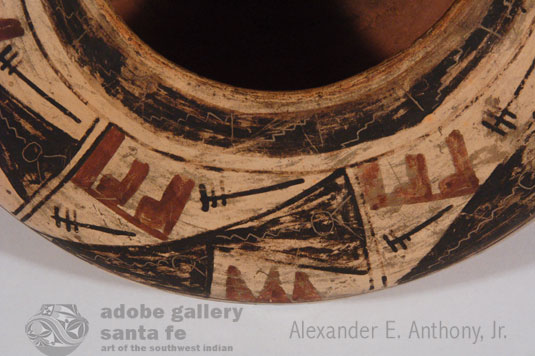Hopi-Tewa Polychrome Jar with Incised Design Elements [SOLD]
+ Add to my watchlist Forward to Friend
- Category: Historic
- Origin: Hopi Pueblo, Hopituh Shi-nu-mu
- Medium: clay, pigment
- Size: 4-¼” height x 9-½” diameter
- Item # C4068T SOLD
 In studying this jar when it arrived, my first impressions were that it was pre-1900 and made by Nampeyo of Hano. After searching all the published photos available and not being able to locate another published jar with the incised designs that appear in the black pigment, it was time to write our Hopi pottery consultant, Dr. Ed Wade.
In studying this jar when it arrived, my first impressions were that it was pre-1900 and made by Nampeyo of Hano. After searching all the published photos available and not being able to locate another published jar with the incised designs that appear in the black pigment, it was time to write our Hopi pottery consultant, Dr. Ed Wade.
His comments were: “What an interesting vessel. This is a Sikyatki reproduction dating to the 1890’s. Not only the motifs and composition attest to this but the unusual incising also substantiates the identification . If you look at page 69 in Canvas of Clay (see reference below) you will note on the pictured magnificent Sikyatki Jar similar etching. This trait has alway been rare and the vast majority of vessels possessing such designs are predominately from Black Mesa at 15th century sites like KoKopeyama, Awatovi, etc.
“I can neither say if it is a Nampeyo or not since on such early reproductions compositions have yet to become individualized. It is a well executed vessel and could very well be her work.” Wade, personal communication
I had actually looked through Canvas of Clay, but missed seeing the jar with similar etching. That jar is also pictured on the jacket cover of the book, so I do not know how I missed seeing it. At any rate, part of the mystery has been solved—there is another published one for comparison.
The jar Dr. Wade references is a Sikyatki Polychrome jar, ca. 1550-1600. This one we are discussing now certainly was influenced by a Sikyatki one.
My belief still is that it was made by Nampeyo because who else would have been doing such exciting work in the 1890s other than Nampeyo. She was the one who was using Sikyatki potsherds as inspiration for her own pottery. I realize that we do not know of documented examples of similar ones to use as proof, but I cannot overlook that I believe it to have been made by Nampeyo.
It has been established that Hopi trader Thomas Keam, who opened his post on the Hopi reservation in 1885 was a major force in elevating Hopi and Hopi-Tewa pottery to its artistic excellence. Keam was providing ancient and contemporary pottery to museums and collectors from his beginning. He recognized the need for the Hopi to earn money and encouraged them to provide pottery for him. He purchased from several potters but immediately recognized the advanced talents of one particular one—Nampeyo of Hano, a Hopi-Tewa of First Mesa. He recognized her as the best potter on the reservation and encouraged her to study and re-introduce designs from the ancient Sikyatki ruins.
I cannot conceive that a potter other than Nampeyo made this exquisite jar, using the incised line concept from the Sikyatki jar that she surely must have been shown. I realize that no similar incised-design jar has been authenticated to her name but that does not eliminate her as the maker. A potter named Paelae was a contemporary but too little information is known about her or her work. Grace Chapella was born in 1874 so would have been too young to do such artistic and creative pottery in the 1890s. That leaves Nampeyo as the logical creator of this jar.
I have stated my opinion but it is up to others to decide if they agree sufficiently to purchase the jar as one by Nampeyo or would wait for more documented proof before doing so. The ultimate decision is up to the purchaser.
This jar has the Fred Harvey paper label attached to the underside, FROM THE HOPI VILLAGES. It also has numerous examples of dragonflies in the design. There is a ceremonial line break throughout the entire design, including both wide framing lines.
The incised line designs that appear in each brown triangle throughout the shoulder area have wavy bodies and a round head with a pair of horns or antenna. It is possible that they represent a water serpent. Also there are incised wavy designs in the wide framing line at the rim. Such wavy lines have been described at representing flowing water.
Condition: There was a small chip on the rim that has been glued back in. Abrasion in both brown and red pigment.
Provenance: this Hopi-Tewa Polychrome Jar with Incised Design Elements is from a collector from Colorado who sent it to us as a Nampeyo creation although he had no documentation to back us his opinion, but neither do we.
Reference: Canvas of Clay: Seven Centuries of Hopi Ceramic Art by Edwin L. Wade and Allan Cooke
Artist Image: We are appreciative to Hopi-Tewa potter, Mark Tahbo, for sharing this photograph with us. The photograph was recently found in a burned out home at First Mesa. This image was later identified as having been taken on July 8, 1913, by photographer Joseph K. Dixon. It is part of the Wanamaker Collection of American Indian Photographs at the Mathers Museum of World Cultures, Indiana University, catalog #1962-08-3279.

- Category: Historic
- Origin: Hopi Pueblo, Hopituh Shi-nu-mu
- Medium: clay, pigment
- Size: 4-¼” height x 9-½” diameter
- Item # C4068T SOLD



